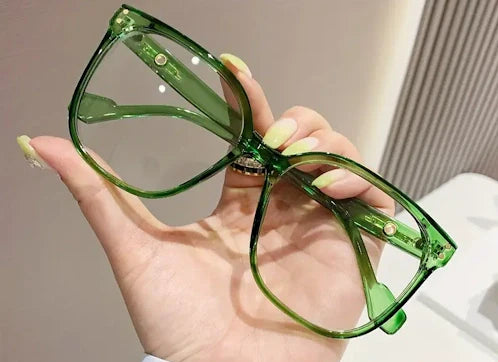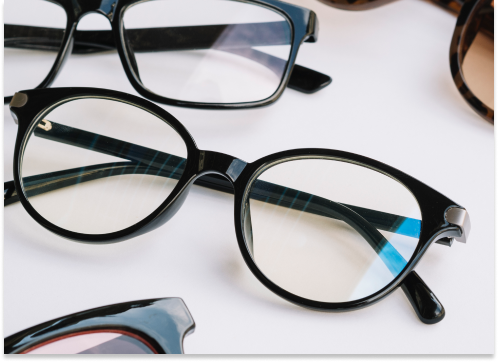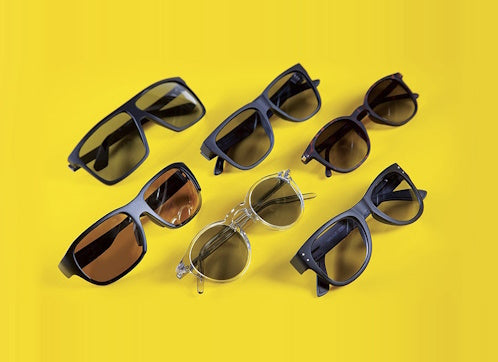
What material are glasses frames made of
The frame of glasses is the main structural component, and its quality determines the overall quality of any pair of glasses. In today's world, a variety of materials are used to manufacture frames. Which of them are preferable, and how do you make the right choice? Today, we will look at the most popular materials, as well as their advantages and disadvantages.
What is a glasses frame?
It consists of two key elements. First, there is the frame itself, into which the lenses are inserted. It consists of two rims connected by a bridge. Glasses frames come in different types—full-rim, which completely encircle the lenses, and semi-rimless, which provide support only at the top or bottom of the lenses. There are also models where the lenses are attached directly to the frame. These variations are called rimless.
The second element is the temples, which attach to the frame and secure the glasses behind the ears.
Popular Materials for Frames
What material are glasses frames made of? The materials used to make eyeglass frames can vary. Among the most in-demand options are plastic and metal. The type of material determines the weight, strength, appearance, heat resistance & even hypoallergenic properties. Often, eyeglass frames feature a harmonious combination of plastic and metal elements. Such models combine the advantages of both materials, allowing for an optimal choice.
Plastic Frames and Their Features
Various basic materials are used for plastic frames. These may include carbon fiber, nylon, cellulose acetate, etc. Plastic is the most popular choice among modern manufacturers. This is due to the fact that the material provides lightness, optimal strength characteristics & a fairly long service life. Additionally, plastic is easy to process, allowing for the creation of frames in a wide variety of shapes and shades. Another significant advantage is the cost of raw materials, which makes plastic frames more affordable.
Let’s take a closer look at what material are glasses frames made of when we speak about plastic:
- Cellulose acetate. This is the most budget-friendly type of plastic. It combines ease and speed of processing with impact resistance, high-temperature durability & longevity. As a result, it can also be used for making sunglasses. Design possibilities are virtually unlimited. These frames can be found among the most well-known brands, including Dolce & Gabbana, PRADA, EMPORIO ARMANI, Michael Kors & many others. One downside of this material is that over time, the frame may fade in areas that come into contact with the skin.
- Nylon. Nylon frames are also frequently found on the modern market. This is a fairly durable material that does not deform under the influence of high or low temperatures. It is an ideal choice for both regular and sunglasses. Nylon is often used to make uniquely shaped frames, sports glasses, as well as stylish designer eyewear. Additionally, nylon is hypoallergenic.
- Optyl. This is another popular material, created from epoxy resins that has many positive recommendations. It is even lighter than cellulose acetate yet more resistant to mechanical damage. Optyl is hypoallergenic and heat-resistant. Furthermore, it allows for truly unique design solutions by incorporating additional decorative elements. A striking example of optyl usage in frame production is the Carrera brand.
- Carbon fiber. This modern polymer is known for its strength and tensile resistance. It is an optimal choice for high-tech and highly durable frames. Since carbon fiber rivals most metals in strength while being significantly lighter, it serves as an excellent alternative. This material can be found in numerous Ray-Ban frames.
- Grilamid. This material is another modern polymer whose main advantage is its resistance to high temperatures. As a result, it does not deform when exposed to heat or UV radiation. Even if you leave these glasses in the sun or on a car dashboard, they will remain intact. This makes it an excellent material for sunglasses.
- SPX. A type of polyamide, SPX offers strength, flexibility, lightness, scratch resistance & durability. Its ability to resist deformation even under heat makes it an excellent choice for sunglasses as well. SPX glasses can be found in eyewear collections by Adidas and Swarovski.
Metal Frames for Eyewear
What is the best material for glasses frames? Below, we provide a few tips. Metal frames are considered more durable and elegant. Most often, these variations are characteristic of regular prescription glasses, though they are also found in many sunglasses. The main requirements for any metal are reliability and resistance to corrosion.
Among the most common metals for frames, the following stand out:
- Aluminum. This is one of the lightest yet optimally strong metals, which is easy to process due to its softness. Aluminum frames do not fade, do not develop stains & do not corrode. Glasses of this type look stylish and modern. Bright examples of aluminum frames include Carrera glasses.
- Titanium. This material is lightweight, strong & hypoallergenic, making it one of the best choices for frames. In addition, it is resistant to corrosion and high temperatures. Due to its elegant appearance and the ability to create frames in various shades, titanium is often used for premium products. In more budget-friendly frames, titanium content is about 70%, combined with additional alloy impurities. Examples of such materials include Beta-Titan, Titan-P & Titanflex. Titanium glasses look solid and truly luxurious. Unique titanium frames can be found, for instance, in ARMANI collections. In reality, this material is rare, accounting for just a bit over 20% of all metal frames produced worldwide. Thus, you can say that your glasses will be exclusive.
- Monel. This material is based on nickel and copper. It is optimally strong and resistant to corrosion and mechanical stress. To ensure hypoallergenic properties, a protective coating (such as lacquer) is applied to the frames. Thanks to its flexibility, monel allows for curved designs. Frames made from this material can be found in metal collections from PRADA, Gucci, Dolce&Gabbana, Carrera, LACOSTE, and more.
- Stainless Steel. This is the most durable yet budget-friendly option for frames. The main drawback in this case is the heavier weight compared to its counterparts. The alloy is made from iron and chromium. Due to the absence of nickel in the composition, such frames do not cause allergic reactions. It is also worth noting that stainless steel is easy to process, allowing for the creation of delicate, sophisticated frame designs with minimal thickness. Many renowned manufacturers offer these frames, including Hugo Boss, Carrera, LACOSTE, Nike, Tom Ford, Prada, and others.
- Flexon. This is a unique metal based on titanium and nickel. Thanks to its memory effect, it can return to its original shape even after deformation. Since Flexon frames are resistant to damage, they are ideal for sports or children's models. Other advantages of this material include its lightness and hypoallergenic properties. Flexon is patented by the Marchon brand.
For the production of elite eyewear, precious metals such as gold may also be used. Naturally, pure gold is never used, as it is too soft. The permissible amount of gold is determined by its karat rating. Although this material is hypoallergenic and resistant to corrosion, it is also quite heavy and expensive. The aesthetic appeal of such frames attracts many, which is why a number of luxury brands offer the option to order gold frames. These include Cartier, Lindberg, and other companies. In addition to gold, silver, platinum, palladium, and rhodium can also be used for frames.
What is the best material for glasses frames?
It’s quite difficult to say definitively what material is the best. It should be noted right away that metal models often surpass any type of plastic in durability. At the same time, any metal is significantly heavier than plastic and cannot offer the same lightness. Metal frames are known for their long lifespan and the elegance of thin lines. Despite this, frames should match personal taste, so modern plastic models can often be far more appealing.
When choosing frames, individual characteristics should be taken into account. First and foremost, this includes skin sensitivity and allergies. For people with sensitive skin, plastic frames are the best choice, as they are completely hypoallergenic. As for metal models, opt for nickel-free frames.
The type of glasses is no less important. Often, plastic is a better option for sunglasses since it doesn’t heat up as much. When purchasing prescription glasses, it’s crucial to consider the thickness of the lenses. Thin lenses pair well with elegant metal frames, while thick lenses require sturdy plastic frames to hold them securely.
The conditions in which the glasses will be used play a critical role. Regardless of the type of glasses (whether for sun protection or vision correction), if they will be used for active pursuits, it’s important to choose more durable and stable materials to simplify care for them.
The key aspects are comfort and appearance. The frame should sit comfortably and look good on you. This means considering the shape and other features of your face. The bridge should not press too hard on the nose, causing discomfort. If the bridge is too loose, the glasses will slide down. It is also recommended that the top of the frame should not rise above the eyebrows, and the bottom should not touch the cheeks. That’s why the shape of both sunglasses and prescription glasses is so important. In any case, personal taste and preferences matter most.
A frame is something you shouldn’t skimp on. It’s always possible to find a budget-friendly yet high-quality material and purchase original products from trusted brands based on online reviews.





